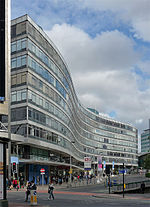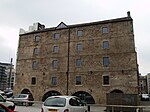Piccadilly Mill
Piccadilly Mill, also known as Bank Top Mill or Drinkwater's Mill, owned by Peter Drinkwater, was the first cotton mill in Manchester, England, to be directly powered by a steam engine, and the 10th such mill in the world. Construction of the four-storey mill on Auburn Street started in 1789 and its 8 hp Boulton and Watt engine was installed and working by 1 May 1790. Initially the engine drove only the preparatory equipment and spinning was done manually. The mill-wright was Thomas Lowe, who had worked for William Fairbairn and helped with the planning two of Arkwright's earliest factories.During the early 1790s the mill employed around 500 workers. Robert Owen was employed as the manager in 1792.
Excerpt from the Wikipedia article Piccadilly Mill (License: CC BY-SA 3.0, Authors).Piccadilly Mill
Auburn Street, Manchester City Centre
Geographical coordinates (GPS) Address Phone number Website Nearby Places Show on map
Geographical coordinates (GPS)
| Latitude | Longitude |
|---|---|
| N 53.4787 ° | E -2.2333 ° |
Address
DoubleTree by Hilton Hotel Manchester - Piccadilly
Auburn Street 1
M1 3DG Manchester, City Centre
England, United Kingdom
Open on Google Maps










